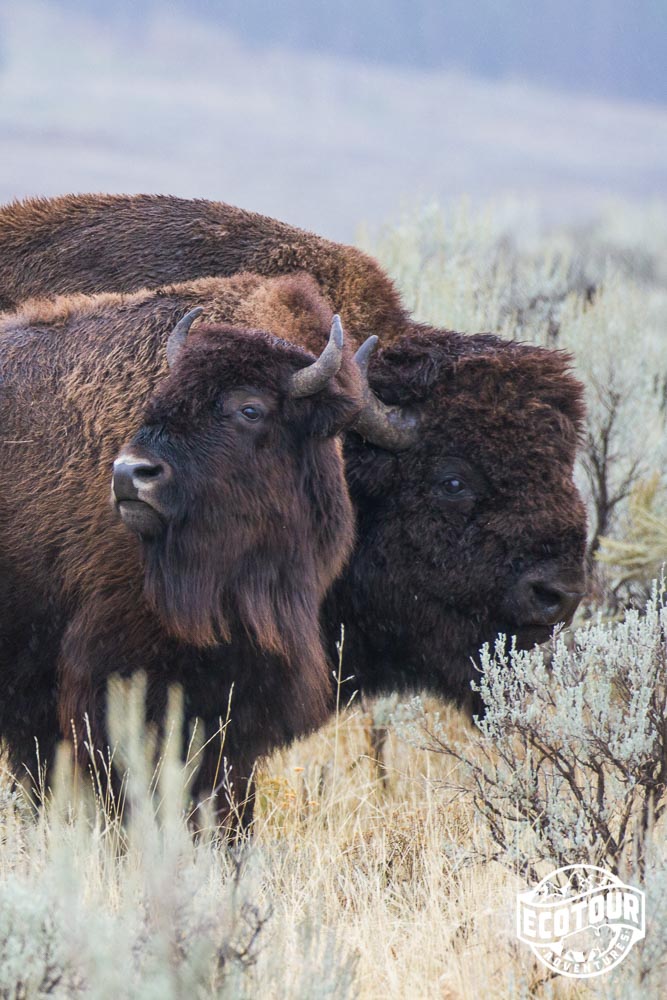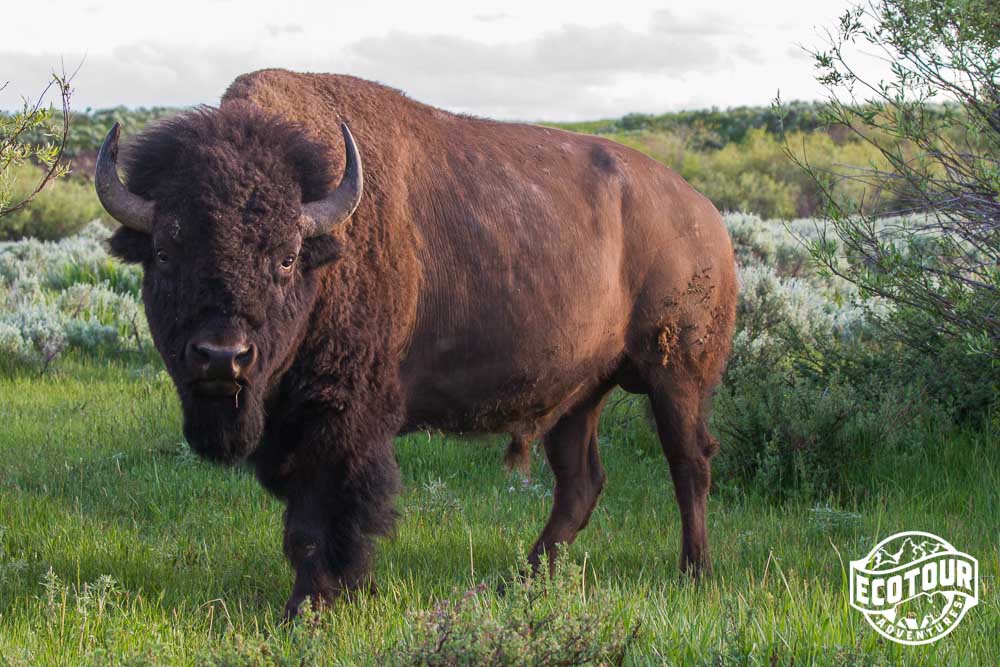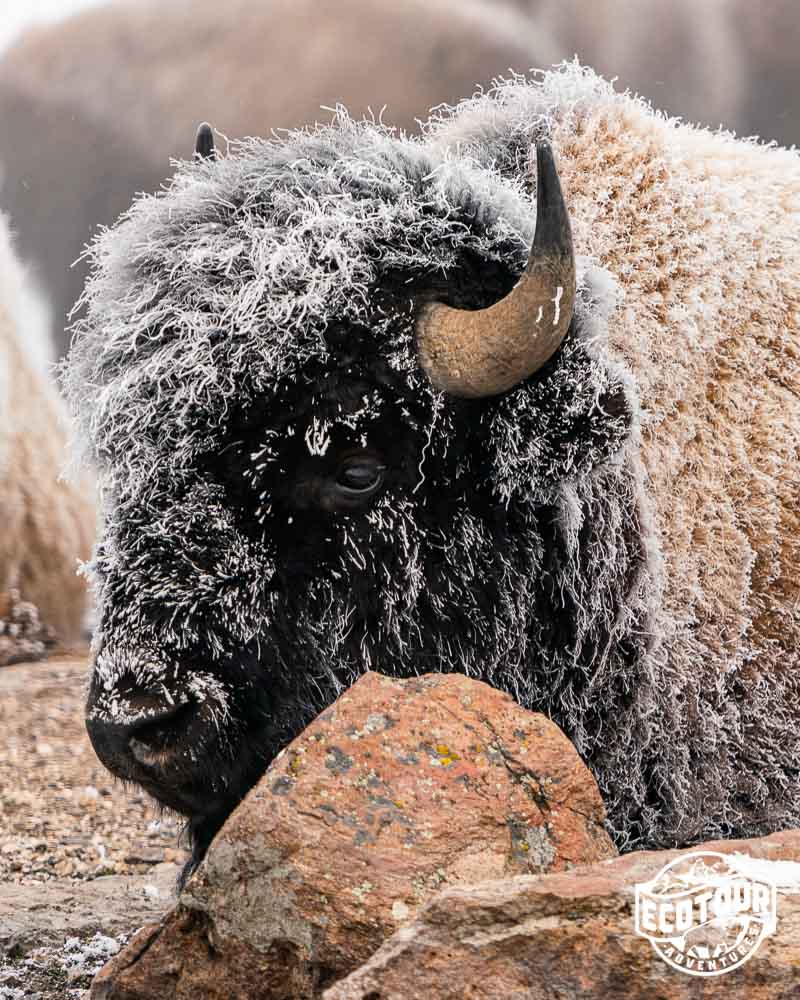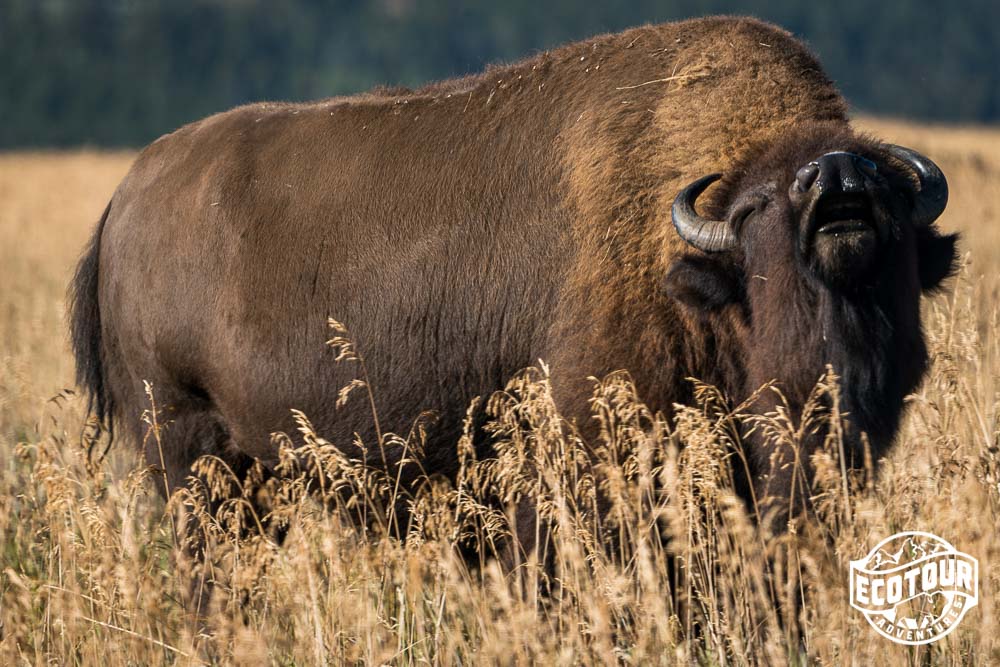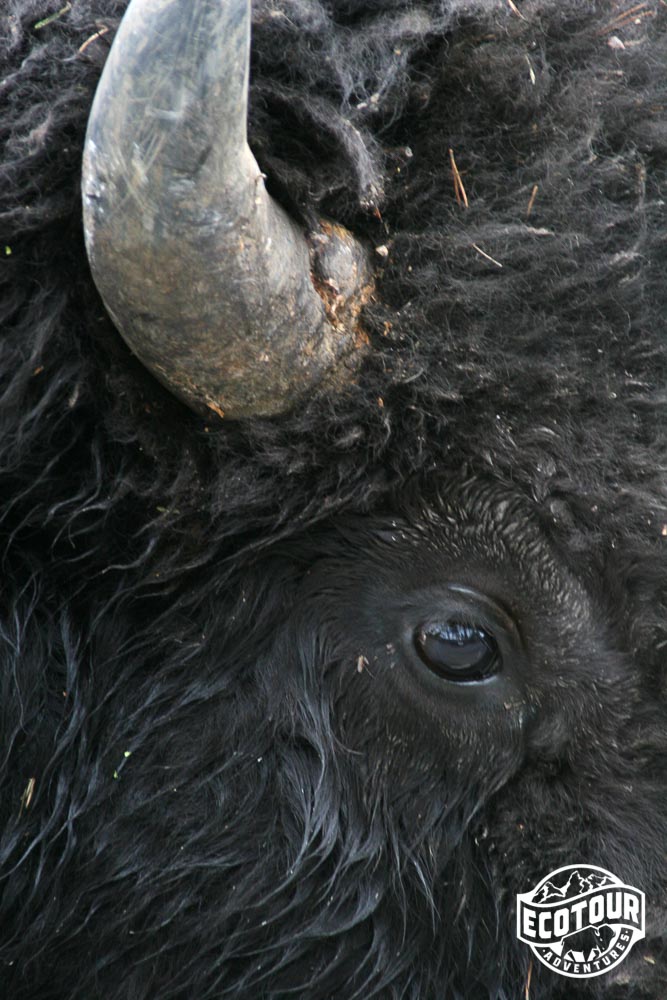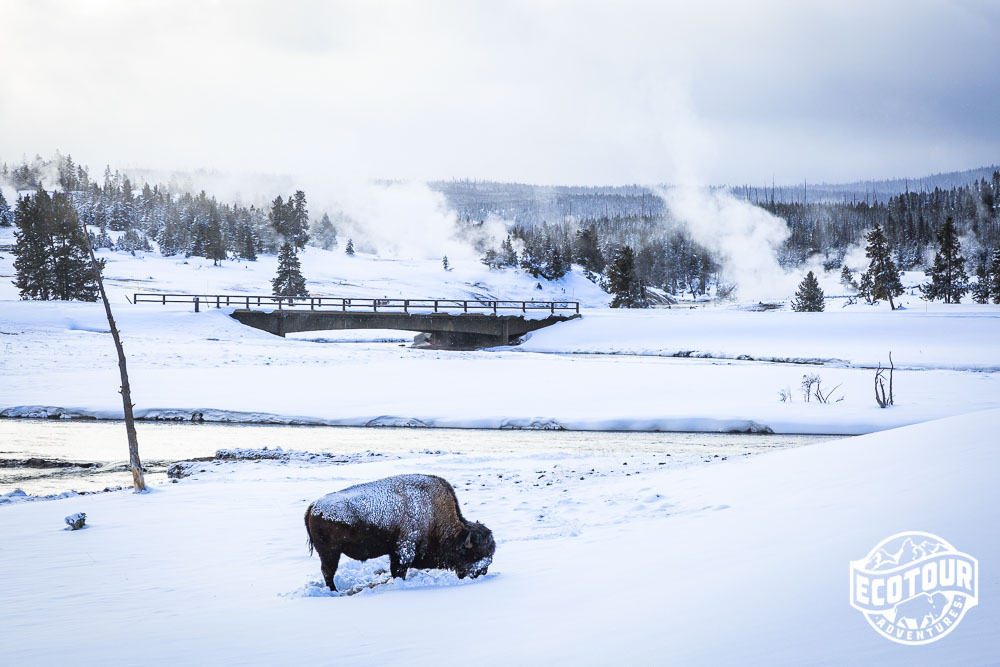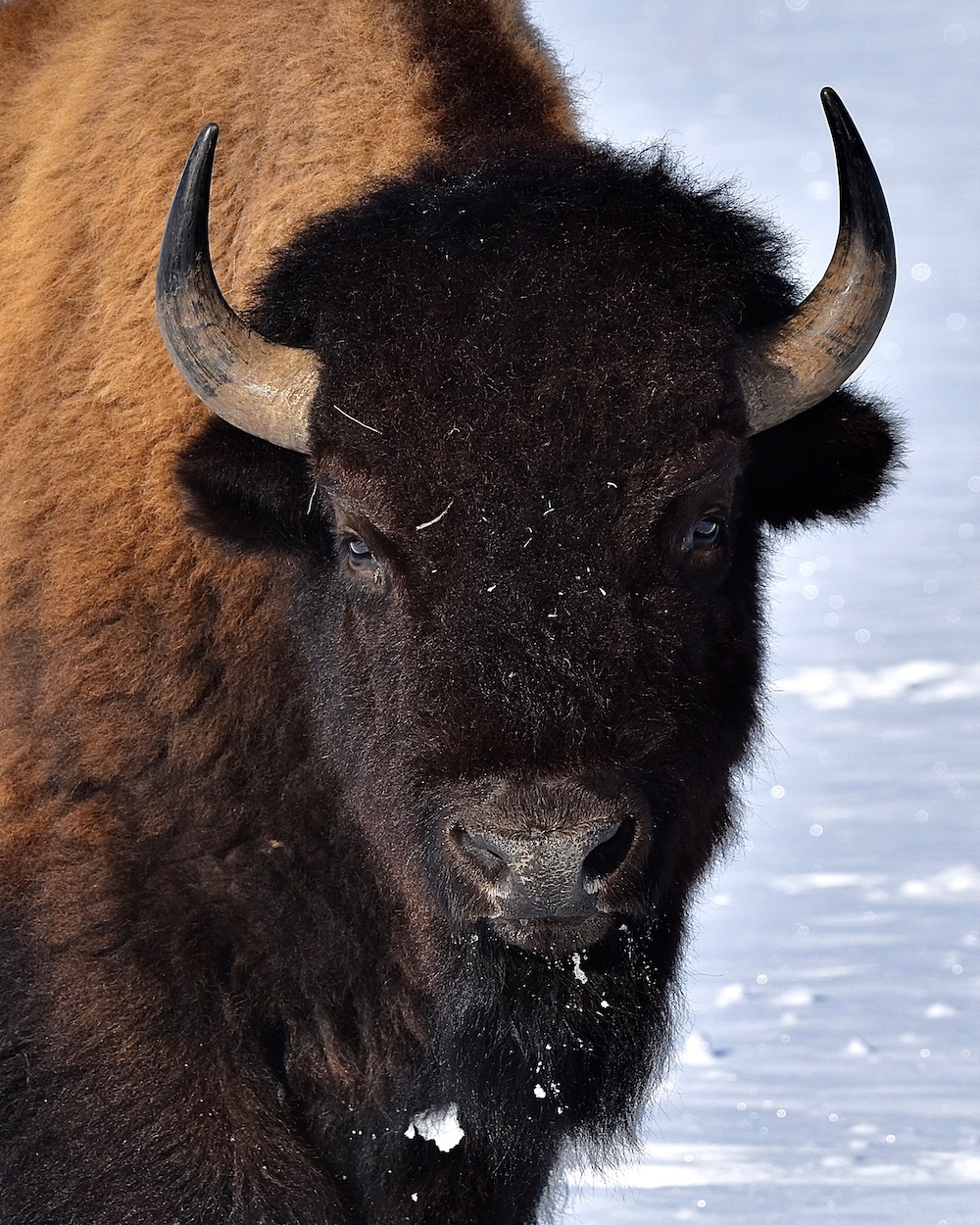Ask a Naturalist: How to Identify Male and Female Bison
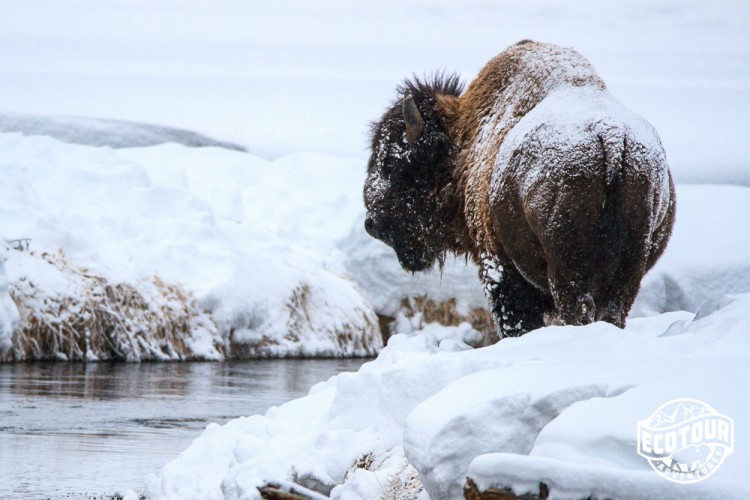
The bulls’ head sweeps left and right, plowing through the deep snow in search of dried grasses from the past summer. Snow piles up on his thick shaggy coat, perfect insulation from the subzero temperatures of Yellowstone. We watch in awe from a distance, taking in the view of this icon of the west, the American bison.
Yellowstone and Grand Teton National Parks are some of the best places in the world to view wild bison year round, and a common question we get is “how do you tell the difference between male and female bison?” Both sexes have horns, meaning even experienced wildlife watchers can be challenged when sexing bison which is why it’s important to use multiple methods of identification. Careful observation in four main areas; horn shape, horn size, head shape, and body characteristics are how we tell the difference. Read on to learn more and take a quiz to test your knowledge!
Using Horn Shape and Size to Identify Male and Female Bison
Of the 8 species of ungulates, or hoofed mammals in the Greater Yellowstone ecosystem, bison are one of the four with horns. Horns are made out of keratin, the same material which comprises our fingernails and hair and will grow throughout the life of the animal. In the GYE this is most pronounced in the curled horn of a bighorn sheep ram, but watch enough bison and you will find some impressively thick horns on mature bulls!
Horn Size - Bison horns are one of the easiest ways to tell gender, though young bulls and cows can be especially confusing. Look for the width of the horn at the base and compare it to the nearby eye. The horn of a bull is usually around twice the diameter of its eye, whereas a cow horn is around the same diameter as its eye.
Horn Shape - As bison age, their horns change shape, which makes them a good indicator of not only gender but age. Yearling bulls and cows have horns that jut out at around a 45 degree angle from their heads. As bulls age their horns tend to stand up more straight while a cow horn will begin curving inward back towards their heads.
In summary, look for a thick base and horn with less curvature to indicate a bull bison, and a thinner, curved horn for cows.
Using Head Shape to Identify Male and Female Bison
The shape of a bison’s head can also help with identification. Bulls often have significantly wider blocky heads with a large mop of hair. The head of a cow bison is usually much more narrow and linear.
Notice the thin, curved horns on the cow bison on the left, and the thicker, more vertical horns on the bull to the right.
Using Body Characteristics to Identify Male and Female Bison
Size - Adult bison range from 1000-2000 lbs, easily the largest animals in the GYE. Bulls end up significantly larger than cows, so if you see a giant it’s probably a bull!
Sex organs - When looking at a bison from the side, look for a penile shaft - a tuft of hair on the belly which helps identify males. Note that sometimes females have tufts of hair in a similar location that can be confusing!
Pelt Color - Bulls often have a two tone pelt, lighter in the front, and darker in the back. Cows are often more of a single tone but can also have a two tone pelt.
Notice the penile tuft, wide head, and thick vertical horns on this bull bison.
Other factors for Identifying Bison Gender
Beyond physical characteristics, behavior often helps us identify male and female bison. Females usually travel in herds, so if you see a solitary bison there’s a good chance it’s a male. Calves often stick quite close to their mothers throughout the first year, another behavioral clue. During the mating season listen for bellowing bulls and watch for paired up bison where one is significantly larger than the other. You are often looking at a bull “tending” a cow and this is a good way to compare physical characteristics side by side.
Test your Bison Knowledge!
Now that you have some tools to identify male and female bison, take a look at the following photos and test your knowledge! Answers at the end of the blog post. (Mobile Users: Click on the photos for a full version)
1. Cow or bull bison?
2. Is the bison on the left a bull or cow?
3. Is the bison on the right a bull or cow?
4. Cow or bull bison?
5. Cow or bull bison?
6. Cow or bull bison?
7. Cow or bull bison?
8. Cow or bull bison?
Observe Wild Bison in Grand Teton and Yellowstone National Parks this Year!
With over 4000 bison in Yellowstone, and around 500 in Grand Teton, the Greater Yellowstone Ecosystem is a great place to take in our National Mammal, any time of year. Bison often grant us intimate views into their lives, whether through binoculars or spotting scopes, or as they walk by our vehicle in one of Yellowstone’s famous “bison jams” Taking a bit of extra time to look for details like the ones we’ve explained here helps us distinguish between individuals, facilitating a deeper understanding and appreciation for these icons of the West.
Bison Quiz Answers:
1. Young Bull - notice the diameter of the horn at the base and how straight up the horn stands.
2. Mature Bull - wide blocky head, large horns that stand vertical.
3. Young Bull - Horns stand vertical and are also wider than the diameter of the eye.
4. Cow - This one is tricky! She looks to be doing a flehmn response which we usually see males do. Notice the curved horns and a skinny horn.
5. Cow - This one is also tricky! Notice the curved horns and a skinny head. The tuft of hair on her belly is not a penile shaft
6. Bull - very wide base of the horn.
7. Bull - solitary, large body, big head, and thick horns.
8. Young Bull - Horns are vertical and the head is starting to become wide.
Josh Metten is a Senior Naturalist with EcoTour Adventures and bison enthusiast who believes “the world needs more bison”
Join us on your next adventure in Grand Teton or Yellowstone National Parks: 307-690-9533 info@jhecotouradventures.com.
Now in our 12th year of operation, Jackson Hole Ecotour Adventures leads wildlife safaris, cross country skiing tours, and snowshoe tours in Grand Teton and Yellowstone National Parks 365 days a year. Let us help maximize your Jackson Hole Experience Today!


